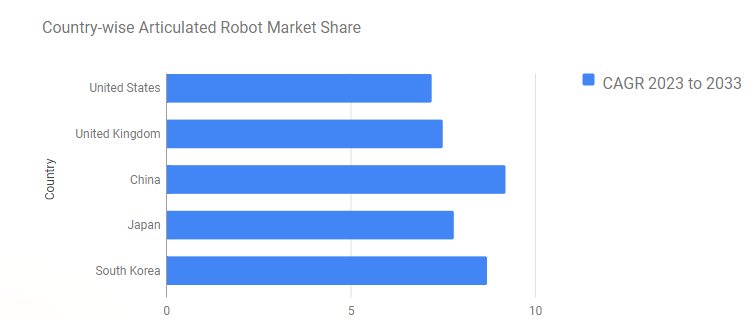Articulated robots, with their flexible arms and human-like movement, are revolutionizing automation across industries. This market, driven by their versatility and efficiency, is experiencing significant growth. Let’s explore the diverse applications of articulated robots and delve into the exciting factors propelling this market forward.
Mimicking Movement for Maximum Impact: Applications of Articulated Robots
The ability to mimic human motion with precision makes articulated robots ideal for a wide range of tasks:
- Manufacturing: From welding and painting car parts to assembling electronics and material handling, articulated robots are transforming production lines, boosting efficiency and productivity.
- Food and Beverage: Articulated robots automate tasks like product packaging, palletizing, and delicate food handling, ensuring hygiene and consistency in food production.
- Logistics and Warehousing: Precise and fast-paced picking and placing of goods in warehouses is a perfect fit for articulated robots, optimizing order fulfillment and storage processes.
- Medical and Pharmaceutical: Robots assist with delicate procedures in surgery, perform sterile and repetitive tasks in laboratories, and handle hazardous materials with precision.
- Agriculture: Automated harvesting, fruit picking, and even planting can be achieved with articulated robots, improving efficiency and addressing labor shortages in the agricultural sector.
Get Exclusive Sample Copy of the Report: https://www.futuremarketinsights.com/reports/sample/rep-gb-17861
A Market Reaching New Heights: Growth Factors on the Rise
The articulated robot market is experiencing a boom driven by several key trends:
- Advancements in Robotics Technology: Developments in sensors, artificial intelligence, and machine learning are leading to smarter robots with improved dexterity, vision systems, and decision-making capabilities.
- Rising Labor Costs and Skills Gap: The increasing cost of manual labor and a shortage of skilled workers in some industries are driving companies to adopt automation solutions like articulated robots.
- Focus on Productivity and Efficiency: Manufacturers are constantly seeking ways to optimize production processes. Articulated robots offer a solution for faster production lines, reduced downtime, and higher quality output.
- Decreasing Robot Costs and Easier Programming: Advancements in robot design and control systems are making articulated robots more affordable and easier to program, opening them up to a wider range of businesses.
- Growing Collaboration Between Humans and Robots: Cobots (collaborative robots) designed to work safely alongside humans are creating new possibilities for human-robot interaction and task delegation.
The Articulated Robot Market is forecasted to account for around USD 20.4 billion in 2033, up from USD 9.2 billion in 2023 advancing at a rate of 8.3% from 2023 to 2033, as per the articulated robots market analysis by FMI.

Challenges and Considerations
The articulated robot market also faces some challenges:
- High Initial Investment: The upfront cost of articulated robots, including installation and programming, can be a barrier for some companies, particularly small and medium-sized enterprises.
- Safety Concerns: Proper safety measures and training for personnel are crucial to avoid accidents when working with powerful robotic arms.
- Job Displacement Concerns: The rise of automation raises concerns about job displacement in certain sectors. However, robots are often creating new jobs in areas like robot maintenance, programming, and system design.
Get Full Report Now: https://www.futuremarketinsights.com/checkout/17861
